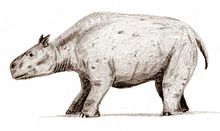Notoungulate
| Notoungulata Temporal range: Paleocene–Pleistocene |
|
|---|---|
 |
|
| Toxodon platensis | |
| Scientific classification | |
| Kingdom: | Animalia |
| Phylum: | Chordata |
| Class: | Mammalia |
| Infraclass: | Eutheria |
| (unranked) | Panperissodactyla |
| Superorder: | †Meridiungulata |
| Order: |
†Notoungulata Roth 1903 |
| Suborders and Families | |
|
See text |
|
See text
Notoungulata is an extinct order of hoofed, sometimes heavy bodied mammalian ungulates that inhabited South America during the Paleocene to , living from approximately 57 Ma to 11,000 years ago.
Due to the isolated nature of South America, many notoungulates evolved along convergent lines into forms that resembled mammals on other continents. Examples of this are Pachyrukhos, a notoungulate that evolved to fill the role of rabbits and hares, and Homalodotherium, which evolved to resemble chalicotheres. During the , Toxodon was the largest common notoungulate. Most of the group (Mixotoxodon and Toxodon being exceptions) became extinct after the landbridge between North and South America was formed, allowing North American ungulates to enter South America in the Great American Interchange and out-compete the native fauna.
This order is united with other South-American ungulates in the super-order Meridiungulata. The notoungulate and litoptern native ungulates of South America have been shown by studies of collagen and sequences to be a sister group to the perissodactyls, making them true ungulates. The estimated divergence date is 66 million years ago. This conflicts with the results of some morphological analyses which favoured them as afrotherians. It is in line with some more recent morphological analyses which suggested they were basal euungulates. Panperissodactyla has been proposed as the name of an unranked clade to include perissodactyls and their extinct South American ungulate relatives.
...
Wikipedia
